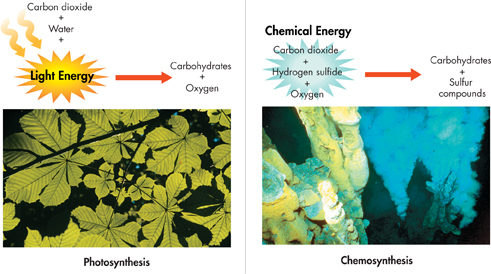Energy From the Sun The best-known and most common primary producers harness solar energy through the process of photosynthesis. Photosynthesis captures light energy and uses it to power chemical reactions that convert carbon dioxide and water into oxygen and energy-rich carbohydrates such as sugars and starches. This process, shown in Figure 3–5 (below left), adds oxygen to the atmosphere and removes carbon dioxide. Without photosynthetic producers, the air would not contain enough oxygen for you to breathe! Plants are the main photosynthetic producers on land. Algae fill that role in freshwater ecosystems and in the sunlit upper layers of the ocean. Photosynthetic bacteria, most commonly cyanobacteria, are important primary producers in ecosystems such as tidal flats and salt marshes.
Life Without Light About 30 years ago, biologists discovered thriving ecosystems around volcanic vents in total darkness on the deep ocean floor. There was no light for photosynthesis, so who or what were the primary producers? Research revealed that these deep-sea ecosystems depended on primary producers that harness chemical energy from inorganic molecules such as hydrogen sulfide. These organisms carry out a process called chemosynthesis (kee moh SIN thuh sis) in which chemical energy is used to produce carbohydrates as shown in Figure 3–5 (below right). Chemosynthetic organisms are not only found in the deepest, darkest ocean, however. Several types of chemosynthetic producers have since been discovered in more parts of the biosphere than anyone expected. Some chemosynthetic bacteria live in harsh environments, such as deep-sea volcanic vents or hot springs. Others live in tidal marshes along the coast.
 In Your Notebook In your own words, explain the differences and similarities between photosynthetic and chemosynthetic producers.
In Your Notebook In your own words, explain the differences and similarities between photosynthetic and chemosynthetic producers.

Figure 3–5 Photosynthesis and Chemosynthesis Plants use the energy from sunlight to carry out the process of photosynthesis. Other autotrophs, such as sulfur bacteria, use the energy stored in chemical bonds in a process called chemosynthesis. In both cases, energy-rich carbohydrates are produced. Compare and Contrast How are photosynthesis and chemosynthesis similar?
dd
Table of Contents
- Formulas and Equations
- Applying Formulas and Equations
- Mean, Median, and Mode
- Estimation
- Using Measurements in Calculations
- Effects of Measurement Errors
- Accuracy
- Precision
- Comparing Accuracy and Precision
- Significant Figures
- Calculating With Significant Figures
- Scientific Notation
- Calculating With Scientific Notation
- Dimensional Analysis
- Applying Dimensional Analysis




